Brief

한눈에 보기
- Many wealthy investors want to increase their holdings of private alternative assets, with between $8 trillion and $12 trillion in household funds available for such assets. Private equity firms and asset and wealth managers are eager to expand their business with individuals.
- For this market to thrive, the current model must evolve into a robust digital system that can efficiently support individual investors at scale.
- Five business archetypes are emerging to overcome the current barriers of high administrative costs, illiquidity, a difficult collateral process for lending, and high minimum investment size.
- The largest wealth and asset managers will likely catalyze developments and can seize a first-mover advantage. Other firms can thrive as challengers or fast followers.
Soon after the financial panic of 1792, 24 stockbrokers and merchants gathered on Wall Street in New York to sign a two-sentence document (in dubious lore, they were shaded by a buttonwood tree). The rules and boundaries they agreed on aimed to reestablish trust in the marketplace and marked the origin of the New York Stock Exchange.
Similar to the Buttonwood Agreement, most financial market milestones have hinged on a solid payment structure and an ecosystem of participants, customers, and regulators. The same economic logic applies in the quest to build a robust, digital infrastructure that will replace today’s bespoke model for private alternative assets. A new system is necessary to meet the large, growing demand for such assets among individuals, and also stands to benefit private equity firms, wealth managers, other providers, and large institutional investors.
Private assets under management are highly concentrated in pension funds and other institutions that invest through private equity partnerships. But while individuals account for just 16% of such assets globally, they hold roughly 50% of global wealth. About 38% of high-net-worth individuals and 53% of very-high-net-worth individuals would like to increase their allocation of private alternative assets (see Figures 1 and 2). They’re looking for greater diversification, and some have noticed family offices allocating a greater share of portfolios to private assets.
Global investors holding $70 trillion in wealth are the biggest underserved candidates for private alternative assets

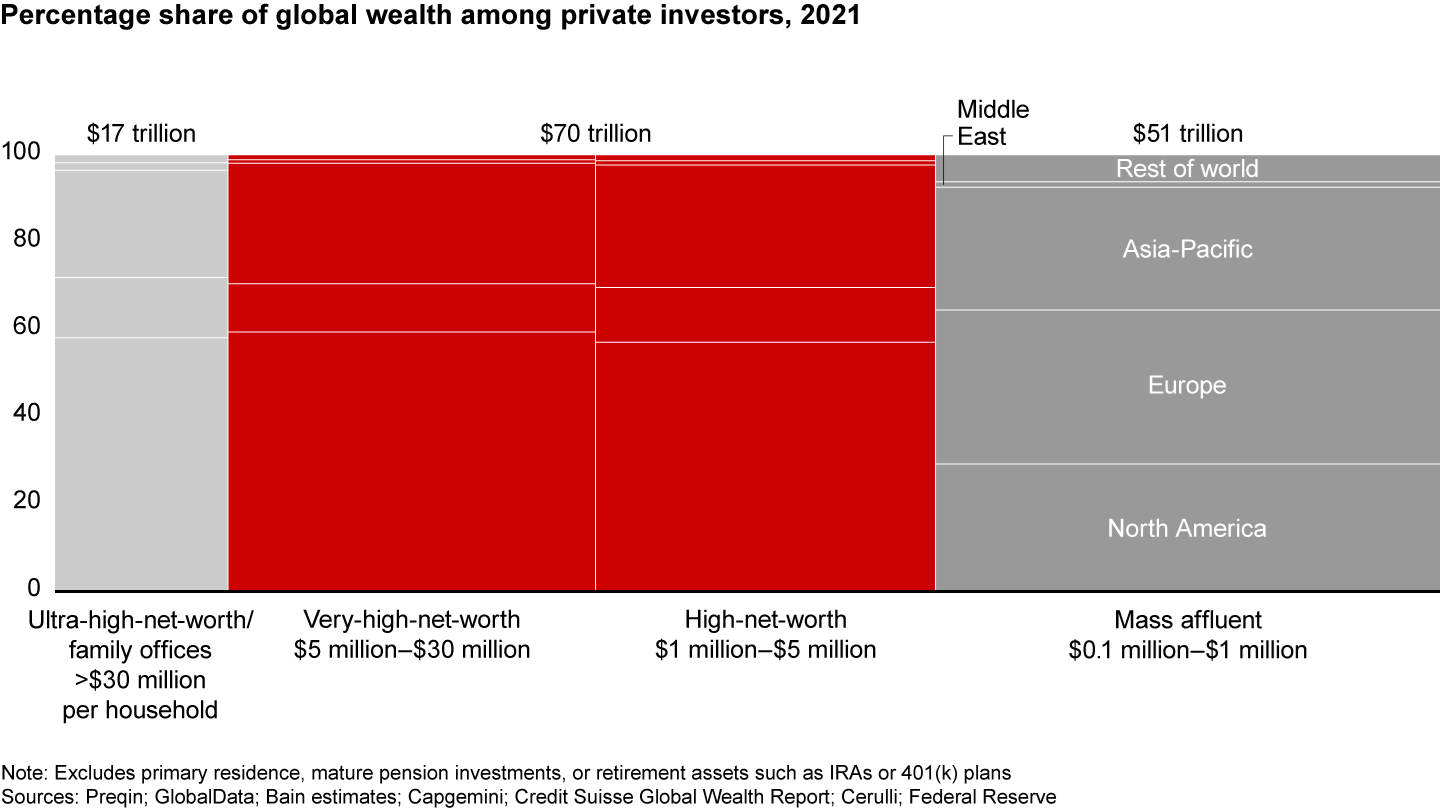
Many individual investors globally want to increase their allocation in private alternative assets

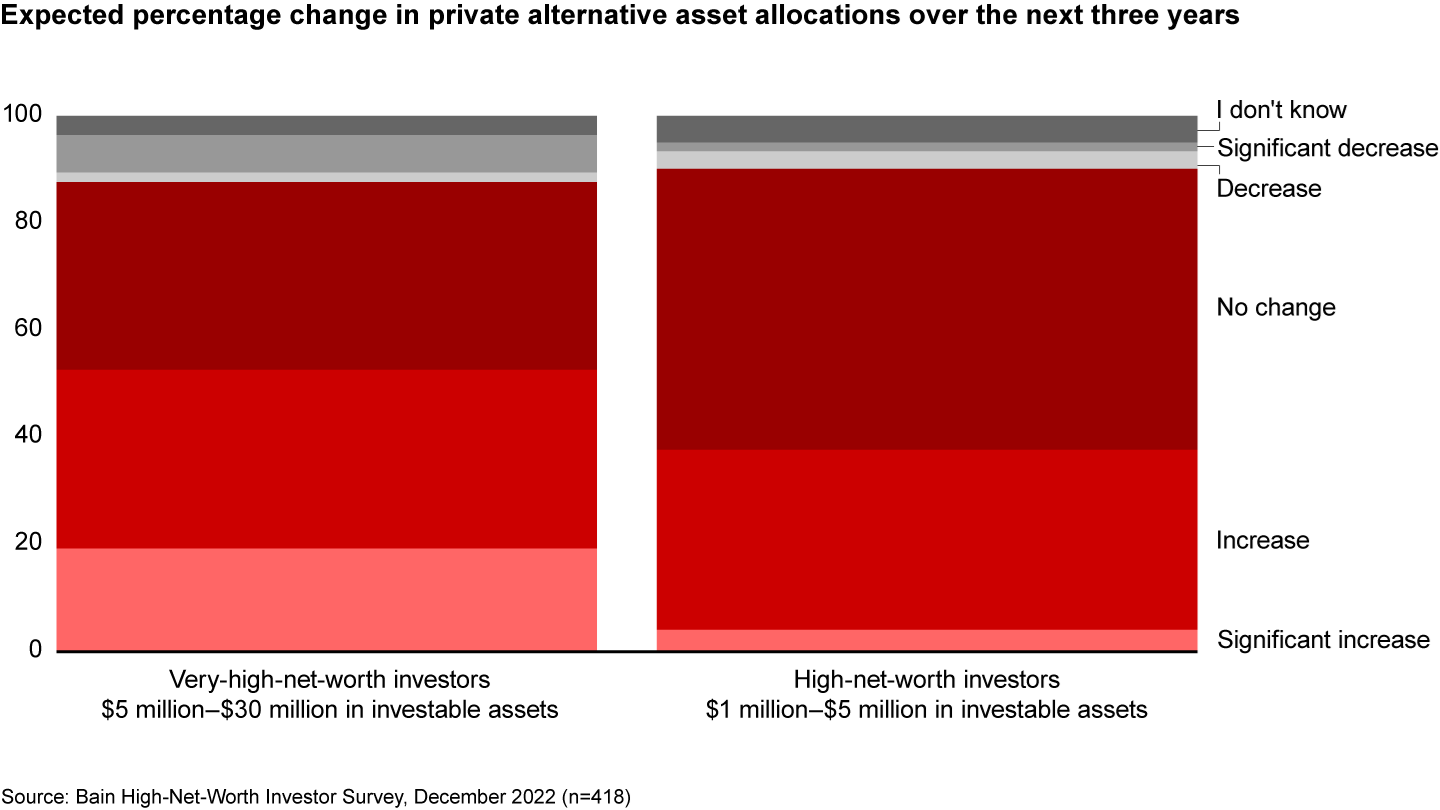
What needs to change
Unlike in public markets, private markets have only limited electronic infrastructure or standards to support transactions, collateralization, administration, registry, and reporting at any scale. Private markets also generally lack transparency on performance, cost, and underlying investments. The current system was designed for large institutional investments with bespoke and manual processes, which, despite their inefficiency, have not created significant problems. However, the lack of a digital, streamlined industrial model makes broad distribution to individuals almost impossible. Building a new industrial model is the answer, but it will entail changes along the industry’s value chain (see Figure 3).
Delivering private alternative investments at scale requires new infrastructure and workflows

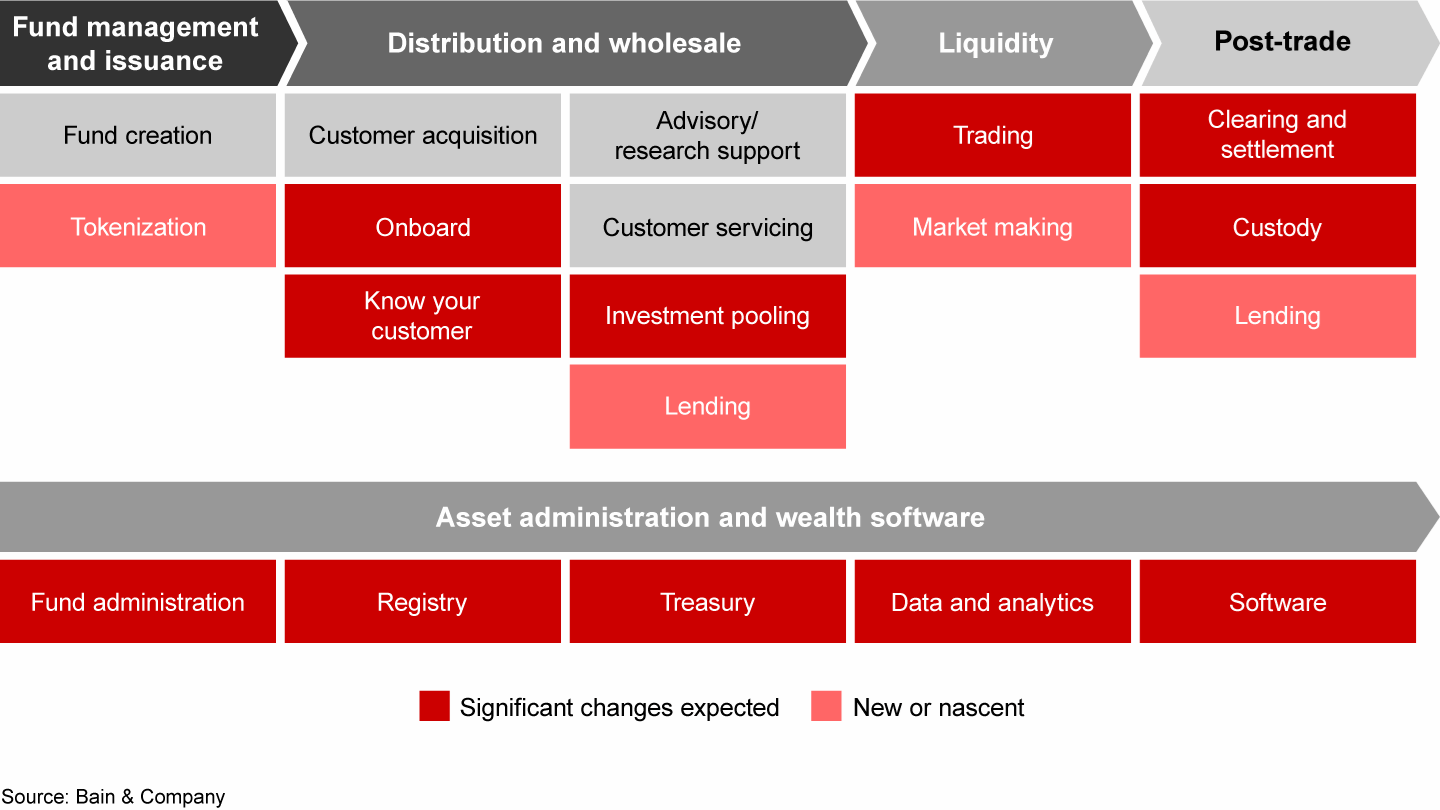
Developing new distribution methods for these assets will also require firms to overcome other barriers as well. To start, private assets are illiquid and have unpredictable cash flows. In addition, managers offering private fund investments struggle to efficiently offer credit using those investments as collateral because they lack established processes and workflows. Moreover, many financial advisors don’t have deep knowledge of private investments, so they don’t offer these assets to clients. Advisers thus will need education and compliance oversight to become comfortable with the attendant risk.

For Digital Assets, Private Markets Offer the Greatest Opportunities
Four emerging business models hold promise by tapping the benefits of distributed ledger technology.
Five emerging archetypes
Several models have emerged to address these barriers. Each has different features and operational and strategic implications for the companies involved.
“Walled-garden” intermediated feeder funds. Some wealth managers can distribute private assets by enrolling existing clients in feeder funds. While this closed architecture limits the scalability of the model, it’s relatively straightforward for large wealth managers with broad capabilities, including Fidelity, Goldman Sachs, UBS, and Morgan Stanley. This model can also provide an early edge that will be hard for smaller firms to replicate. Keeping the business in-house could be easier than coordinating with third parties. And the model gives large firms control in the absence of a market infrastructure. We estimate that firms using this model currently manage more than $300 billion of assets.
Direct-to-consumer feeder funds. Feeder funds on digital platforms, which can be tokenized, sell directly to investors. Securitize, for instance, helps asset managers such as KKR and Hamilton Lane bring private assets onto a blockchain via its end-to-end tokenization platform and regulated secondary exchange. Access to customers could be tricky for this model. Most high-net-worth client assets are held by wealth managers, making it difficult for direct-to-consumer funds to dislodge those assets and scale up. And existing wealth management channels offer services that many investors value, such as advice, portfolio management, credit, and reporting.
Platform partnerships. Platform partners work with wealth managers to develop a curated set of private investment options that wealth managers can sell to their clients. iCapital, for instance, is a financial technology company with a platform that provides alternative investment solutions to investment professionals. An early entrant, it has rapidly scaled up a two-sided market of general partners and potential limited partner investors. iCapital’s market making, along with a sophisticated online portal and technology, has attracted wealth managers seeking to provide access to private assets.
Emerging market infrastructure. Regulated trading venues have emerged to facilitate transactions and liquidity of private alternative asset funds, or similar vehicles such as feeder funds. ADDX is one company providing a regulated platform for the offering, settlement, custody, and secondary trading of digital securities. By operating an integrated suite compliant with regional securities laws, ADDX has built an institutional-grade platform attractive to large funds. And its user-friendly portal has attracted investors.
Industry-level market infrastructure and standards. In this open architecture model, separate parties provide trading, settlement/clearing, and transfer/registry for private assets, akin to public market infrastructure. For instance, private companies and their shareholders can list their shares on Nasdaq Private Market’s platform for institutional investors and family offices to purchase. The platform provides distribution of shares, and infrastructure for trading, clearing, and settling accounts.

Why Private Equity Is Targeting Individual Investors
Retail investors account for half of all wealth globally. No wonder alternative funds have them in their sights.
A likely market evolution
While multiple archetypes will likely coexist for years, we expect platform partnerships to further develop and proliferate in the medium term. Firms that run platforms, such as iCapital, or large traditional asset management companies, will partner with alternative asset managers, exchanges, and custodians to distribute private assets to individual investors.
Over the longer term, we expect a more efficient, shared, open-market infrastructure to take root. Reaching full potential in this market will require a coordinated approach. The future market structure will likely include some combination of distributed ledger technology models and data standards, which can yield efficiencies across the value chain, evolving regulations, and traditional, centralized infrastructure akin to today’s public markets.
Across all of these archetypes, private alternative assets will need to adopt a range of new features to serve different client segments and needs, along with a digital infrastructure that will make new features feasible. But product and feature innovation will depend on the establishment of standards and infrastructure (see Figure 4).
The predominant archetypes for private alternative assets will evolve

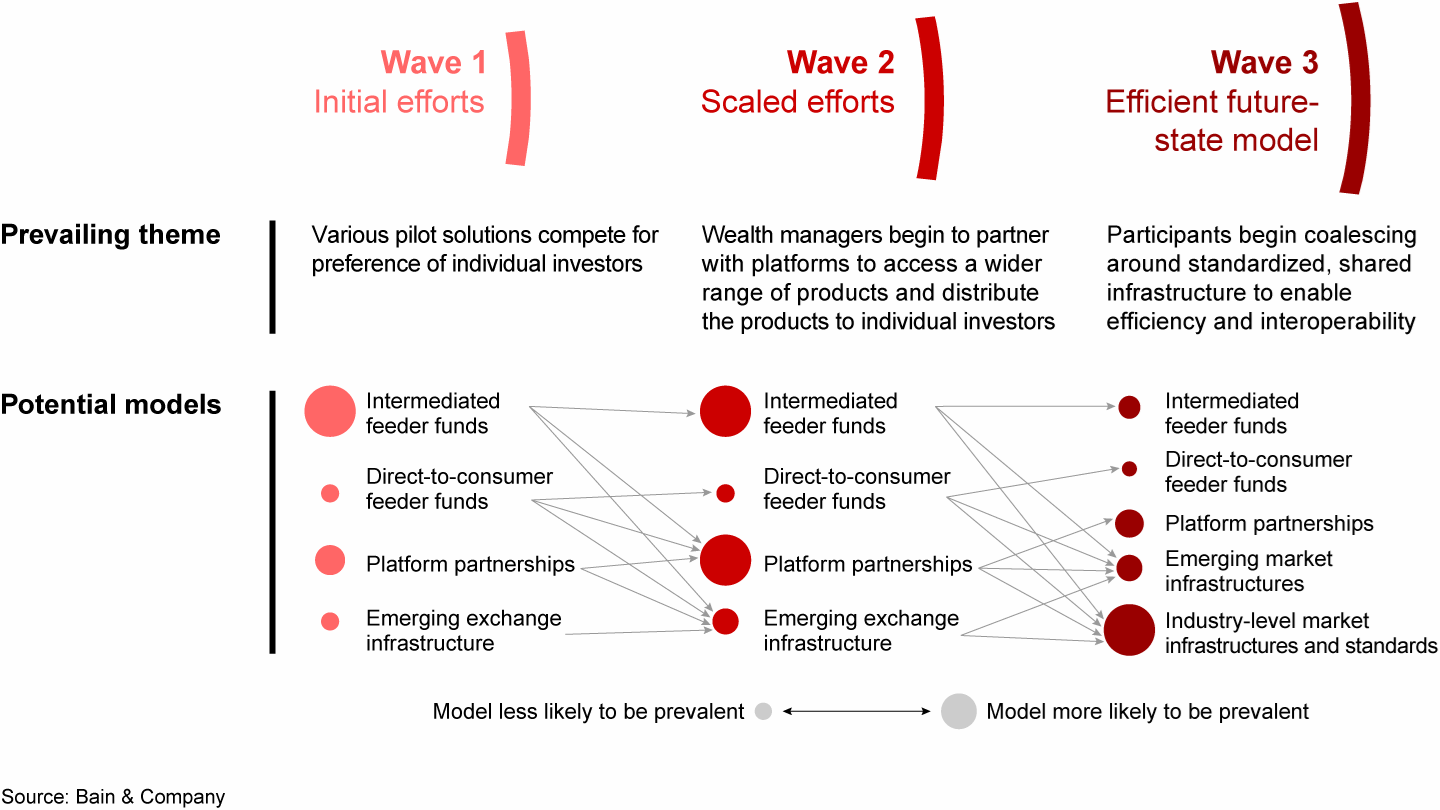
At a minimum, a system that appeals to more investors and asset managers should incorporate several common characteristics. As noted above, initial investment levels will have to be lowered. Creating a predictable cadence for capital calls will make cash flow easier for many clients. Structured liquidity mechanisms will provide a transparent and reliable secondary market via monthly or quarterly tenders, which would work for most individual investors. Allowing assets to serve as collateral and enable lending are important features for individual investors, and lending generates net interest income for wealth managers. And subscribing to a fund, tax documentation, and reporting should be automated and digital (see Figure 5).
Some features of private alternative investments will need to change to accommodate more individual investors

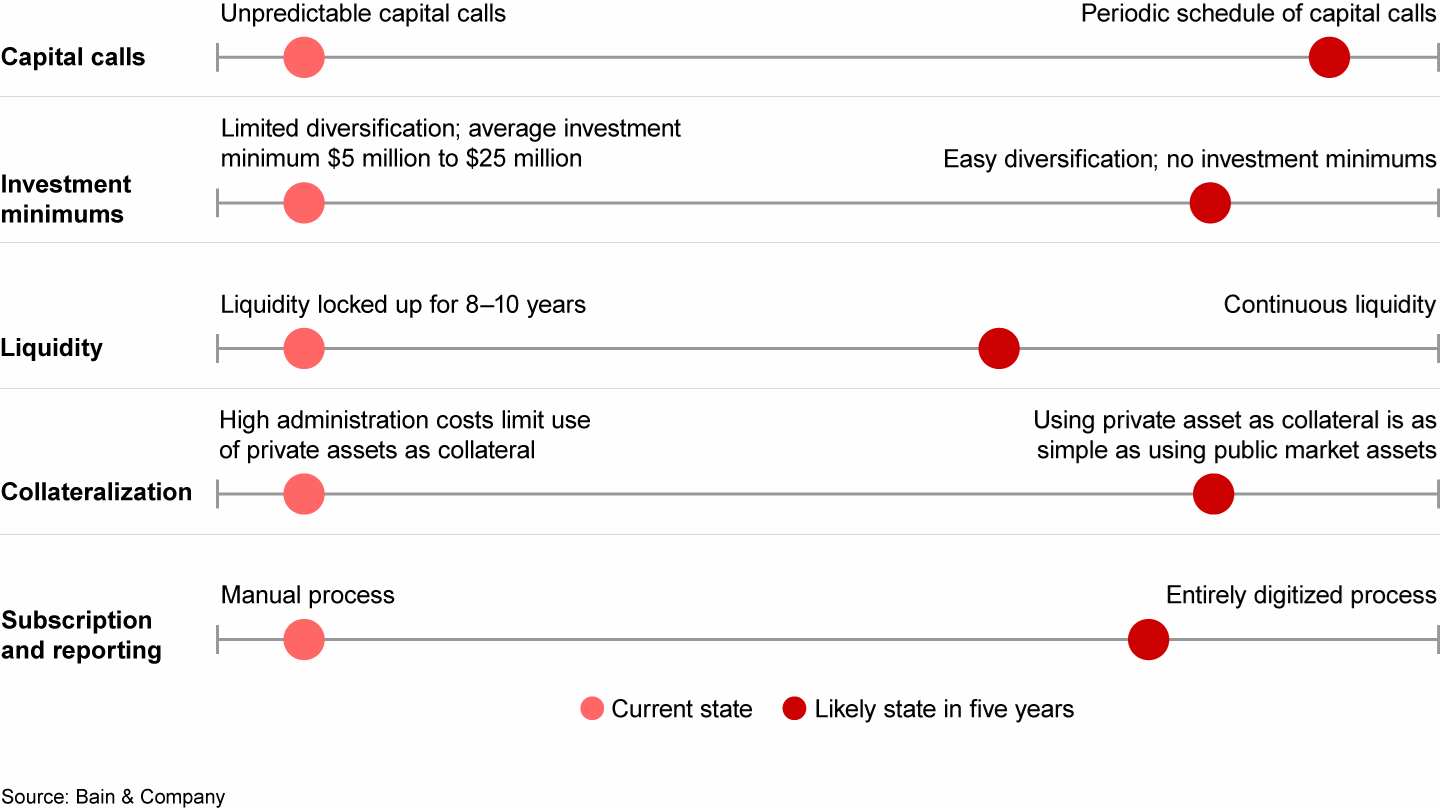
The biggest choice for companies is which archetype to pursue. Once that’s determined, further choices include:
- Target customers: Which wealth segments to target? Which formats and features are most appropriate for each segment?
- Product design and regulation: What product structure? What liquidity features? How could assets be used for loan collateral?
- Workflow and operations: How to develop and implement end-to-end models? What mix of technology platforms to use?
- Go-to-market approach: How to educate financial advisers and clients? How to trade off walled-garden models vs. industry-level models?
As with other market infrastructure developments, the largest wealth and asset managers will likely catalyze and shape the development of the private asset market—and can seize first-mover advantages. Custodians, exchanges, fintechs, data providers, and smaller firms can also thrive as challengers or fast followers, as new digital market infrastructure evolves and enables innovation and growth.
Besides the desire among asset managers for growing their client base, millions of accredited and qualified individual investors crave private alternative assets, if only companies and regulators can collaborate to create structures as robust and transparent as public markets. The supply and demand imperatives are clear; what’s missing is the plumbing and the standards, just as in 1792.